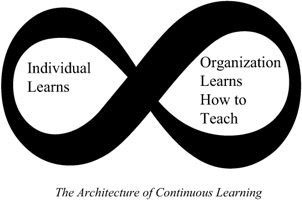Double Loop Learning: The Organization Starts to Learn
"Learning how to learn" will be the first order of business.
—Don Marchand and F. Horton: Infotrends, 1986
At the heart of and connecting both machine systems and living systems is the process of double-loop learning. The concept derives originally from Bateson and Ashby, and was further amplified as a metaphor for organizational models by Schon and Argyris (see 1974 in Fastpaths below). Double-loop learning is the theory of how and where individual learning meets organizational learning. The term itself derives from the "feedback loops" drawn on engineering drawings and circuit designs. Translated into the training realm, the first feedback loop refers to the learning done by a student (from feedback provided on tests), whereas the second loop refers to the learning done by the trainer (from course evaluations). Thus, as the student learns how to perform better, the trainer learns how to train better (as both a designer and deliverer of training). In fact, the trainer is practicing what might be called meta-training, learning how to learn AND train better. Learner and trainer are intertwined in an ongoing system that is continuously improving itself. The two feedback loops joining the two participants in the system are what we call double-loop learning (see Figure 6). This lies at the heart of organizational systems design.

Figure 6: Organizational Systems Design.
EAN: 2147483647
Pages: 110